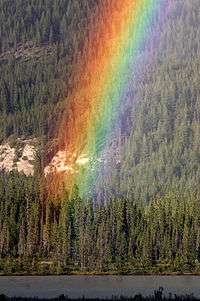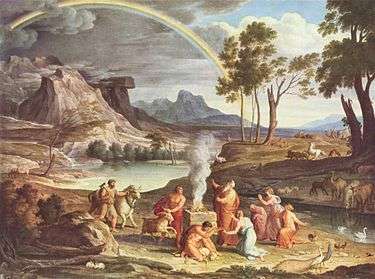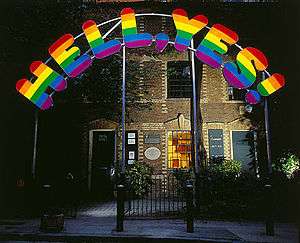Rainbows in culture
The rainbow, a natural phenomenon noted for its beauty and its place in the sky, has been a favorite component of art and religion throughout history.
Religious belief

The rainbow has a place in legend owing to its beauty and the historical difficulty in explaining the phenomenon.
In Greco-Roman mythology, the rainbow was considered to be a path made by a messenger (Iris) between Earth and Heaven.
In Chinese mythology, the rainbow was a slit in the sky sealed by goddess Nüwa using stones of five different colours.
In Hindu religion, the rainbow is called Indradhanush, meaning "the bow (Sanskrit and Hindi: dhanush is bow) of Indra, the god of lightning, thunder and rain". Another Indian mythology says the rainbow is the bow of Rama, the incarnation of Vishnu. It is called Rangdhonu in Bengali, dhonu (dhanush) meaning bow. Likewise, in mythology of Arabian Peninsula, the rainbow, called Qaus Quzaħ in Arabic, is the war bow of the god Quzaħ.
In Armenian mythology the rainbow is a belt of Tir, a Sun god.
In Norse Mythology, a rainbow called the Bifröst Bridge connects the realms of Ásgard and Midgard, homes of the gods and humans, respectively.
The Irish leprechaun's secret hiding place for his pot of gold is usually said to be at the end of the rainbow. This place is impossible to reach, because the rainbow is an optical effect which depends on the location of the viewer. When walking towards the end of a rainbow, it will appear to "move" further away (two people who simultaneously observe a rainbow at different locations will disagree about where a rainbow is). Also, a rainbow is in fact a full circle, we usually only see the half arc of it due to our positioning in respect to it; if you were to be positioned higher up (such as on a tall building or an airplane) then you could view it's actual full circle. So in reality there is no end to a rainbow, just as there is no end to a circle. Therefore, that 'end of the rainbow' is in other words an impossible/non-existent place.
Another ancient portrayal of the rainbow is given in the Epic of Gilgamesh: the rainbow is the "jewelled necklace of the Great Mother Ishtar" that she lifts into the sky as a promise that she "will never forget these days of the great flood" that destroyed her children. (The Epic of Gilgamesh, Tablet Eleven)
Then Ishtar arrived. She lifted up the necklace of great jewels that her father, Anu, had created to please her and said, "Heavenly gods, as surely as this jewelled necklace hangs upon my neck, I will never forget these days of the great flood. Let all of the gods except Enlil come to the offering. Enlil may not come, for without reason he brought forth the flood that destroyed my people."
According to Genesis, after Noah's flood God put the rainbow in the sky as the sign of His promise that He would never again destroy the earth with flood (Genesis 9:13–17):[1]
I do set my bow in the cloud, and it shall be for a token of a covenant between me and the earth. And it shall come to pass, when I bring a cloud over the earth, that the bow shall be seen in the cloud: And I will remember my covenant, which is between me and you and every living creature of all flesh; and the waters shall no more become a flood to destroy all flesh. And the bow shall be in the cloud; and I will look upon it, that I may remember the everlasting covenant between God and every living creature of all flesh that is upon the earth. And God said unto Noah, This is the token of the covenant, which I have established between me and all flesh that is upon the earth.
The Church of Jesus Christ of Latter-Day Saints founder and prophet Joseph Smith stated that the second coming of the Christ would not occur in any year in which a rainbow is seen.[2]
In the Dreamtime of Australian Aboriginal mythology, the rainbow snake is the deity governing water.
In Amazonian cultures, rainbows have long been associated with malign spirits that cause harm, such as miscarriages and (especially) skin problems. In the Amuesha language of central Peru, certain diseases are called ayona’achartan, meaning "the rainbow hurt my skin". A tradition of closing one's mouth at the sight of a rainbow in order to avoid disease appears to pre-date the Incan empire.[3][4]
In New Age and Hindu philosophy, the seven colours of the rainbow represent the seven chakras, from the first chakra (red) to the seventh chakra (violet).
Art
Rainbows are generally described as very colourful and peaceful. The rainbow occurs often in paintings.[5] Frequently these have a symbolic or programmatic significance (for example, Albrecht Dürer's Melancholia I). In particular, the rainbow appears regularly in religious art (for example, Joseph Anton Koch's Noah's Thank Offering). Romantic landscape painters such as Turner and Constable were more concerned with recording fleeting effects of light (for example, Constable's Salisbury Cathedral from the Meadows). Other notable examples appear in work by Hans Memling, Caspar David Friedrich, and Peter Paul Rubens.
 The Blind Girl, oil painting (1856) by John Everett Millais. The rainbow – one of the beauties of nature that the blind girl cannot experience – is used to underline the pathos of her condition. |
 Noah's Thank Offering (c. 1803) by Joseph Anton Koch. Noah builds an altar to the Lord after being delivered from the Flood; God sends the rainbow as a sign of his covenant (Genesis 8–9). |
In contemporary visual art, the rainbow often appears as well, notably in Peter Coffin's Untitled (Rainbow), 2005,[6] and in Ugo Rondinone's Hell, Yes!, 2001.[7] Like many other cultural references to the rainbow, these either emphasize the possible sublimity of the natural world or the cheerfulness, joy, and celebration often culturally associated with a profusion of colors.
 Ugo Rondinone's Hell, Yes!, 2001, neon, perspex and translucent film, 284 x 734 x 15 centimeters. |
%2C_2005%2C_30_inkjet_prints%2C_T-Pins_%C2%A9_Peter_Coffin%2C_2005.jpg) Peter Coffin, Untitled (Rainbow), 2005, 30 inkjet prints, T-Pins |
In 2012, American artist, Michael Jones McKean created a large-scale artwork, The Rainbow.[8] The project created, impart, a fully sustainable prismatic rainbow using thousands of gallons of pressurized harvested rainwater, at times stretching several city blocks in size.[9]
Literature
Judith Bauer Stamper's 1987 Find Your Fate book "Jem and The Holograms #3: The Secret of Rainbow Island ", involves the reader in saving Rainbow Island, a tropical island that frequently has rainbows.
American legend retelling The Rough Face Girl" involves the heroines seeing an invisible Chief, who wears a rainbow as a sash.
Stephen King's 1985 book 'It features a scene where Ben Hanscom sees a spray bow while fighting with Henry Bowers in The Barrens, and comments on finding gold at the end of it.
The 1983 Care Bears book "A Sister for Ben" involves Cheer Bear, whose tummy symbol is a rainbow, telling Ben he will see a rainbow when his sister says her first word.
Dan Piraro's comic strip Bizzaro featured a 2008 cartoon about fictional pirate Rainbowbeard in response to Proposition 8.
The rainbow inspires metaphor and simile. Virginia Woolf in To the Lighthouse highlights the transience of life and Man's mortality through Mrs Ramsey's thought,
- "it was all as ephemeral as a rainbow"
Wordsworth's 1802 poem "My Heart Leaps Up" begins:
- My heart leaps up when I behold
- A rainbow in the sky:
- So was it when my life began;
- So is it now I am a man;
- So be it when I shall grow old,
- Or let me die!...
The Newtonian deconstruction of the rainbow is said to have provoked John Keats to lament in his 1820 poem "Lamia":
- Do not all charms fly
- At the mere touch of cold philosophy?
- There was an awful rainbow once in heaven:
- We know her woof, her texture; she is given
- In the dull catalogue of common things.
- Philosophy will clip an Angel's wings,
- Conquer all mysteries by rule and line,
- Empty the haunted air, and gnomed mine –
- Unweave a rainbow
In contrast to this is Richard Dawkins; talking about his book Unweaving the Rainbow: Science, Delusion and the Appetite for Wonder:
"My title is from Keats, who believed that Newton had destroyed all the poetry of the rainbow by reducing it to the prismatic colours. Keats could hardly have been more wrong, and my aim is to guide all who are tempted by a similar view, towards the opposite conclusion. Science is, or ought to be, the inspiration for great poetry."
Music
- In Rainbow Connection, a song known for being sung by Kermit the Frog, the idea of a rainbow is seen as something to wish on, as it is popularly seen as a vision, or symbol of hope.
- In End of the Rainbow by September, the singer sings about the rainbow, and how she will be at the end of the rainbow and her ex could see her there when he reaches the end of the rainbow.
- End of the Rainbow is an award winning stage play with music (or musical drama) by Peter Quilter.
- The group Rainbow and the song Rainbow Demon by Uriah Heep.
- I Can Sing a Rainbow is a popular children's classic song written by Arthur Hamilton, despite the name of the song, not all the colours mentioned are actually colours of the rainbow.
- Ronnie James Dio used rainbows as a thematic element in many of his songs, particularly as singer and lyrics-writer for Ritchie Blackmore's band Rainbow. Most notable among these are the songs Catch the Rainbow, Rainbow Eyes and the Dio song Rainbow in the Dark.
- The band Radiohead released an album in 2007 named, In Rainbows.
- The South Korean band Rainbow
- Over the Rainbow is a song sung by the character Dorothy Gale (Judy Garland) in the musical film The Wizard of Oz.
- Doo wop bands The Rainbows and Randy and the Rainbows
- Japanese singer, Ayumi Hamasaki, has an album named RAINBOW with the same song name.
- Rainbow Country by Bob Marley.
- Touch the Rainbow is a song by the German band Axxis, released in 1990 on the album Axxis II.
- Rainbow is a song by Jessie J.
- Double Rainbow (song) by Katy Perry.
Films
- In A Shine of Rainbows, the young protagonist is promised to be taken into a rainbow.
- In Marianne, a double rainbow was filmed by chance when Sandra is introduced for the first time.
- In Rainbow, damage to a rainbow threatens the world at large.
- In the film The Wizard of Oz, lead character Dorothy Gale sings the song "Over the Rainbow" where she fantasises about a place over the rainbow, where the world is in peace and harmony.
- Hallmarks 1983 series Rainbow Brite ", about a superhero who keeps the world colorful and alive. She and the Color Kids live in Rainbowland. In 1985 there was a film for the series, Rainbow Brite and the Star Stealer. Rainbow Brite uses the rainbow to travel between Rainbowland and Earth. Her horse Starlite has a rainbow mane and tail.
- The Rainbow Warrior was a spaceship featured in the 1983 series He-Man and the Masters of the Universe episode "The Rainbow Warrior".
- The film The Serpent and the Rainbow
- In The Care Bears Cheer Bear has a rainbow as a tummy symbol and True Heart Bear and Noble Heart Horse have pastel rainbow hair.
- Space Cases character Catalina has rainbows hair.
- Double Rainbow (viral video)
Computer games
- In Rainbow Islands, a 1987 arcade game, rainbows are used for fighting enemies.
Flags
Rainbow flags tend to be used as a sign of a new era, of hope, or of social change. Rainbow flags have been used in many places over the centuries: in the German Peasants' War in the 16th century, as a symbol of the Cooperative movement; as a symbol of peace, especially in Italy; to represent the Tawantin Suyu, or Inca territory, mainly in Peru and Bolivia;[10] by some Druze communities in the Middle east; by the Jewish Autonomous Oblast; to represent the International Order of Rainbow for Girls since the early 1920s, and as a symbol of gay pride and LGBT social movements since the 1970s.[11][12] In the 1990s, Archibishop Desmond Tutu and President Nelson Mandela described the newly democratic South Africa as the "rainbow nation".
References
- ↑ Holy Bible: (King James Version.) (2004). Intellectual Reserve, inc.
- ↑ "I have asked of the Lord concerning His coming; and while asking the Lord, He gave a sign and said, "In the days of Noah I set a bow in the heavens as a sign and token that in any year that the bow should be seen the Lord would not come; but there should be seed time and harvest during that year: but whenever you see the bow withdrawn, it shall be a token that there shall be famine, pestilence, and great distress among the nations, and that the coming of the Messiah is not far distant." Teachings of the Prophet Joseph Smith, Section Six 1843-44, p.340
- ↑ Céline Valadeau, Joaquina Alban Castillo, Michel Sauvain, Augusto Francis Lorese and Geneviève Bourdy (January 8, 2010). "The rainbow hurts my skin: Medicinal concepts and plants uses among the Yanesha (Amuesha), an Amazonian Peruvian ethnic group". Journal of Ethnopharmacology. 127 (1): 175–192. doi:10.1016/j.jep.2009.09.024. PMID 19835943.
- ↑ Webster, Patty. "Utilizing Western and Traditional Remedies in the Peruvian Amazon".
- ↑ Niels Hutchison. "Stairways to Heaven". Colour Music. http://www.colourmusic.info/rain.htm/
- ↑ Announcement on e-flux http://www.artandeducation.net/announcement/utah-museum-of-fine-arts-presents-the-smithson-effect/
- ↑ Ugo Rondinone
- ↑ http://www.huffingtonpost.com/2012/05/23/michael-jones-mckean_n_1539378.html
- ↑ http://michaeljonesmckean.com/interview-gaddy.html
- ↑ "Flagspot.net". Flagspot.net. Retrieved 2010-10-16.
- ↑ "The Rainbow Flag". Retrieved 2007-08-21.
- ↑ Gilbert Baker (October 18, 2007). "Pride-Flyin' Flag: Rainbow-flag founder marks 30-years anniversary". Metro Weekly. Washington DC. Retrieved 2008-03-13.